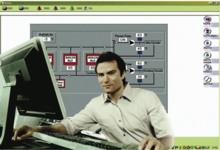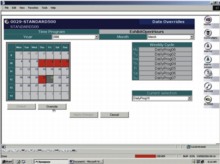High-tech — but is it easy to operate?

Building-management applications should exploit the familiarity of the Windows environment.
JEFF HOWLETT argues that to be effective in managing building services and optimising energy consumption and costs, building-management systems should be powerful and easy to operate.Building management has moved upwards technologically in huge leaps and bounds over the past 15 years. From stand-alone controls, it has progressed through propriety automation systems to open networks providing integration of every building application. Industry-standard networks ensure vendor independence, interoperability and great versatility. The control interface for HVAC plant has progressed from a collection of wall-mounted instruments in the boiler room, through desk-mounted control panels housed in custom furniture — often sited in a dedicated control room — to current monitoring and controlling applications, accessed from a standard PC on the building LAN. Their use of Internet protocols (IP) and standard web browsers can allow a building system to be accessed and operated from anywhere in the world using the Internet.
Reliable heritage Early open systems for distributed building control were not developed as new from the base up. They used platforms developed for industrial processes and were already well-proven to monitor and control critical production processes such as chemical and pharmaceutical production. The technology adapted easily to building management, where their extreme reliability and versatility were huge benefits. However, there is a huge difference between a chemicals plant, with its dedicated control room staffed by highly-trained engineers who understand the technicalities of the system, and the staffing practices in a typical building. Other than in very large buildings with dedicated personnel, day to day system operation is just one small duty of many assignments in an employee’s working day. That person may be a facility manager, but is also likely to be a receptionist or a secretary. A building system installed today will take a comprehensive view of many possible ways to minimise the fuel consumed and energy wasted, while ensuring comfort. It may be self-adaptive and use its past experience to optimise energy consumption. It may also include many complex control algorithms, feedbacks and techniques. But these must all be completely automated and run in the background, so those who manage the building from day to day will never have to bother about the technicalities or programming, or have to make continuous adjustments.
Familiar interface They are greatly assisted when the operator interface uses a familiar, standard web browser such as Internet Explorer or Mozilla Firefox. For cost and operational reasons, it is a great advantage when the application is accessed on a standard PC. Web-enabled control also enables the building’s network to be monitored and operated internally via a LAN or WAN, or elsewhere using the Internet.
 |
| — People who are used to mainstream office applications should find it easy to prepare time and temperature schedules for rooms, and it should be obvious how to make changes as needed. |
The PC and the Windows environment are familiar in virtually all workplaces. The building-management application should exploit this familiarly whilst being intuitive and, therefore, very easy to use and understand. Personnel used to mainstream office applications should find it easy to prepare time/temperature schedules for rooms, with a few mouse movements and clicks. It should be obvious how to make changes instantly as needed. It is a great benefit when the system allows building managers to monitor each building’s energy consumption and review trends in temperature and fuel usage. Such analysis can reveal places where energy is being wasted, leading to further savings. Information from many buildings can be collected at a central point using the Internet and provide instant data on energy costs in each building and how they vary from day to day, week to week and month to month. Application expertise is built in The key to maximising energy savings is, of course, software and applications which have been well-thought-out, well-proven and configured to the specific needs of the building. Provided all the software know-how is embedded, with hundreds of different selectable applications and parameter settings to choose from, installation and commissioning will be easy. There is then no need to program in applications using specialist programming tools. Setting up can be simply a matter of selecting an application and naming the tags. The chosen application will have well-proven control algorithms and software mechanisms for a fast, problem-free start up. Building management to optimise energy consumption and costs is no longer a luxury but a ‘must have’ in these days of high fuel costs and awareness of global warming. A user-friendly interface and built-in expertise will make the task of saving energy altogether painless.
Jeff Howlett is an engineering sales support engineer for CentraLine by Honeywell, a member of the Building Controls Industry Association
Related links:
Related articles:









